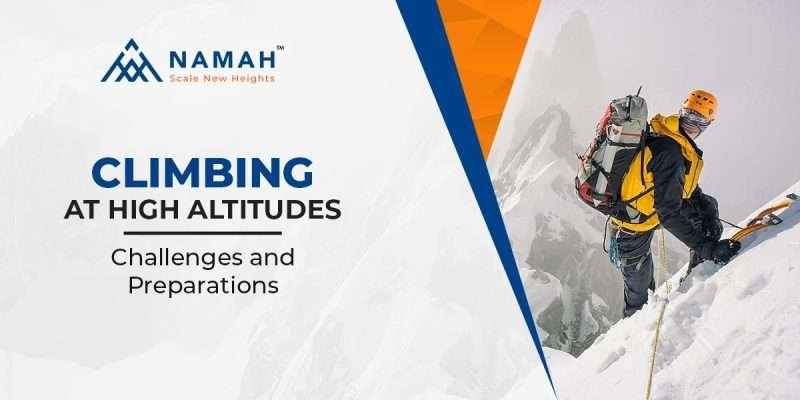High-altitude climbing presents a unique set of challenges that push both climbers’ physical limits and their ability to adapt to harsh environments. Unlike climbing at lower elevations, where the air is thick with oxygen and conditions are relatively forgiving, high-altitude climbs take mountaineers into the realm of low oxygen levels, extreme cold, and thin air.
In this comprehensive guide, we’ll delve into the challenges associated with high-altitude climbing and explore the essential preparations and safety measures climbers should undertake before embarking on these awe-inspiring but demanding journeys.
The Allure of High-Altitude Climbing
High-altitude climbing has an irresistible allure. It beckons adventurers to conquer some of the world’s most iconic peaks, from the Himalayas to the Andes. The appeal lies not only in the sheer thrill of reaching summits but also in the breathtaking vistas that can only be found at these lofty heights. However, the intoxicating beauty and sense of accomplishment come at a price, and understanding the unique challenges is paramount.
The Thin Air Dilemma
One of the defining characteristics of high-altitude climbing is the thin air. As you ascend, the air pressure decreases, and the concentration of oxygen molecules drops significantly. At sea level, the oxygen content is around 21%, while at 8,000 meters (26,247 feet), it’s a mere 9%. This severe reduction in oxygen availability can lead to a range of altitude-related illnesses, including the potentially fatal high-altitude pulmonary edema (HAPE) and high-altitude cerebral edema (HACE).
Acclimatization: Your Body’s High-Altitude Adjustment
Acclimatization is the process by which your body adapts to the reduced oxygen levels at high altitudes. It’s a crucial aspect of high-altitude climbing and can mean the difference between success and failure, or even life and death.
The Essentials of Acclimatization
Achieving successful acclimatization involves several key strategies:
Gradual Ascent
Climbers should follow the principle of “climb high, sleep low.” This means ascending to higher altitudes during the day and descending to lower altitudes for sleep. This strategy helps the body adjust to reduced oxygen levels by exposing it to higher elevations temporarily.
Adequate Hydration and Nutrition
Proper hydration and nutrition are essential for acclimatization. Dehydration can exacerbate altitude-related illnesses, while a balanced diet ensures the body has the energy and nutrients needed for optimal performance and adaptation.
Altitude Training
Some climbers use altitude training before their expeditions. This involves living and training at moderate altitudes to stimulate the production of red blood cells and improve the body’s ability to transport oxygen.
Gear and Equipment for High-Altitude Climbing
High-altitude climbing requires specialized gear and equipment to withstand the extreme conditions. From clothing to oxygen systems, climbers need to carefully select their gear to ensure safety and comfort in this challenging environment.
Clothing and Layering
High-altitude climbs expose climbers to extreme cold, so proper clothing is crucial. Layering is a common technique to trap warmth and manage moisture effectively.
Oxygen Systems
At extreme altitudes, supplemental oxygen can be a lifesaver. Climbers often use bottled oxygen to maintain adequate oxygen levels and reduce the risk of altitude-related illnesses.
High-Altitude Tents
These specialized tents create a controlled environment for climbers to sleep in, helping with acclimatization and providing a haven from harsh weather.
The Mental Challenge of High-Altitude Climbing
The mental aspect of high-altitude climbing is just as demanding as the physical. Climbers face isolation, extreme conditions, and the constant threat of altitude-related illnesses. Mental preparation and resilience are vital.
Psychological Training
Preparing mentally involves psychological training to cope with isolation, fear, and the uncertainty of high-altitude climbs.
Decision-Making Skills
Climbers must make critical decisions about turning back if conditions worsen or if they experience altitude-related symptoms. The ability to assess risks and prioritize safety is paramount.
High-Altitude Climbing: The Ultimate Test
High-altitude climbing isn’t for the faint of heart. It demands rigorous preparation, unwavering determination, and a deep respect for the environment. In part two of this guide, we’ll explore safety measures, medical considerations, and stories of triumph and tragedy on the world’s highest peaks.
Safety Measures for High-Altitude Climbing
Safety should always be the top priority when undertaking high-altitude climbs. Here are some essential safety measures to consider:
Emergency Communication
High-altitude climbs often take climbers far from civilization, making communication challenging. Satellite phones and emergency beacons can provide a lifeline in case of emergencies.
Team Dynamics
Climbing in a team provides safety through numbers. Effective teamwork, communication, and trust among team members are vital.
Weather Monitoring
High-altitude environments are notorious for rapidly changing weather conditions. Regular weather monitoring and the ability to interpret forecasts are crucial for safety.
Medical Considerations in High-Altitude Climbing
Altitude-related illnesses can strike suddenly and severely. Understanding these conditions and having a plan to address them is essential:
Acute Mountain Sickness (AMS)
AMS is a common ailment at high altitudes. Symptoms include headaches, nausea, fatigue, and dizziness. Mild cases can often be managed by descending to lower elevations.
High-Altitude Pulmonary Edema (HAPE) and High-Altitude Cerebral Edema (HACE)
These are severe and life-threatening conditions that require immediate descent and medical attention.
Triumph and Tragedy: Stories from High-Altitude Climbing
High-altitude climbing has a storied history, filled with tales of incredible achievements and heartbreaking losses. Here are a few stories that highlight the triumphs and challenges of scaling the world’s highest peaks:
Sir Edmund Hillary and Tenzing Norgay
In 1953, Sir Edmund Hillary of New Zealand and Tenzing Norgay, a Sherpa of Nepal, became the first climbers to reach the summit of Mount Everest. Their historic ascent marked a milestone in human achievement.
The 1996 Everest Disaster
Chronicled in Jon Krakauer’s book “Into Thin Air,” the 1996 Mount Everest disaster remains one of the deadliest tragedies in climbing history. Eight climbers lost their lives in a fierce storm.
Reinhold Messner
Italian climber Reinhold Messner is renowned for his numerous solo and alpine-style ascents of 8,000-meter peaks. His minimalist approach to climbing has set new standards for alpinists.
Preparing for Your High-Altitude Adventure
Now that you have a comprehensive understanding of the challenges, preparations, and safety measures involved in high-altitude climbing, you’re better equipped to embark on your own high-altitude adventure. Remember that proper training, acclimatization, and a respectful approach to the environment are key to a successful climb.




